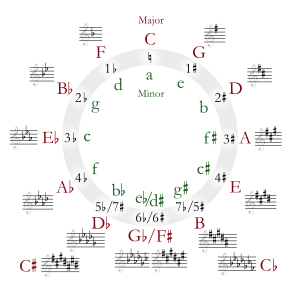C major facts for kids
C major is a major scale that starts on the note C. Think of it as a musical ladder made of seven special notes: C, D, E, F, G, A, and B. When you play these notes in order, it sounds bright and happy!
One cool thing about C major is its key signature. It doesn't have any sharps (notes that are a little higher) or flats (notes that are a little lower). This makes it one of the easiest keys to play, especially on a piano using only the white keys.
C major has a "musical cousin" called A minor. This is its relative minor key. Both C major and A minor use the exact same notes (all white keys on a piano). C major also has a "twin" called C minor, which is its parallel minor key. They both start on C but sound different because C minor uses some flat notes.
Contents
What are Scales and Keys?
In music, a scale is a set of musical notes ordered by their pitch. It's like a musical alphabet that helps you build melodies and harmonies. A key is the main group of notes that a piece of music uses. It gives the music its overall sound and feeling.
The C Major Scale
The C major scale is often the first scale musicians learn because it's so simple. It uses only the white keys on a piano.
- C (the first note, or "root")
- D
- E
- F
- G
- A
- B
- Then it repeats with C again, but an octave higher.
This pattern of whole steps and half steps (the distances between notes) is what makes it a "major" scale. It sounds bright and cheerful.
Key Signatures Explained
A key signature is a set of sharps or flats written at the beginning of a piece of music. These symbols tell you which notes should always be played a little higher or lower throughout the song.
C major is special because its key signature has no sharps or flats. This means you play all the notes exactly as they are, without changing them. This is why many beginner songs are written in C major.
| Diatonic Scales and Keys | |||||||||||||||||||||||||||||||||||||||||||||||||||||||
|---|---|---|---|---|---|---|---|---|---|---|---|---|---|---|---|---|---|---|---|---|---|---|---|---|---|---|---|---|---|---|---|---|---|---|---|---|---|---|---|---|---|---|---|---|---|---|---|---|---|---|---|---|---|---|---|
|
|||||||||||||||||||||||||||||||||||||||||||||||||||||||
| The table shows the number of sharps or flats in each scale. Minor scales are written in lower case. | |||||||||||||||||||||||||||||||||||||||||||||||||||||||
Why is C Major Important?
C major is very important in music for several reasons:
- Easy to Learn: Because it uses only white keys on a piano, it's often the first key taught to new musicians.
- Foundation for Music Theory: Understanding C major helps you learn about other scales and keys. Many musical concepts are first explained using C major as an example.
- Common in Popular Music: Many popular songs, especially those meant to sound simple and happy, are written in C major.
- Used in Teaching: Music teachers often use C major to introduce basic harmony and melody writing.
Compositions in C Major
Many famous composers have written pieces in C major. Its clear and bright sound makes it a popular choice for all kinds of music.
- Classical Music: Famous pieces like Joseph Haydn's "Surprise Symphony" (Symphony No. 94) and parts of Ludwig van Beethoven's Symphony No. 1 are in C major.
- Modern Music: Many pop, rock, and folk songs also use C major because of its simple and appealing sound.
See also
 In Spanish: Do mayor para niños
In Spanish: Do mayor para niños


